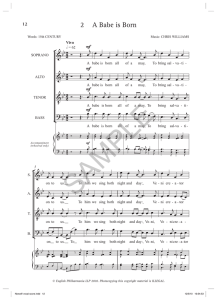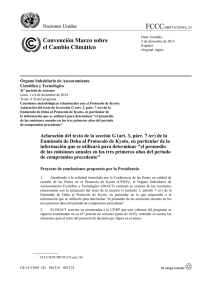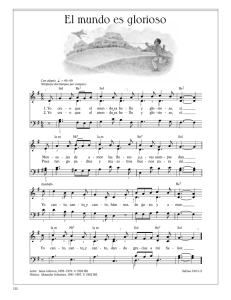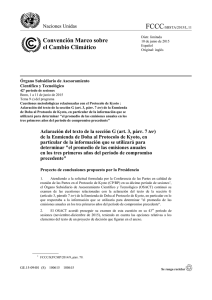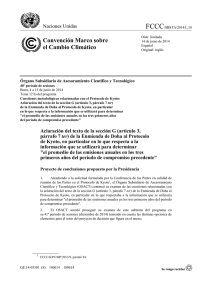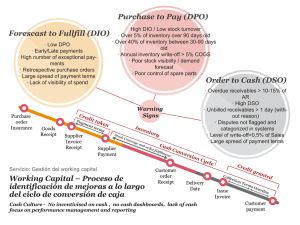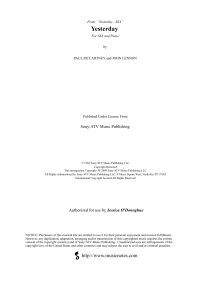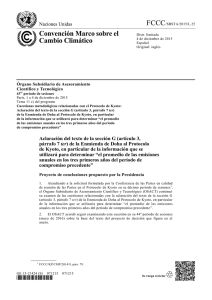IMSLP30201-PMLP66937-Tallis Spem in alium full score PML
Anuncio
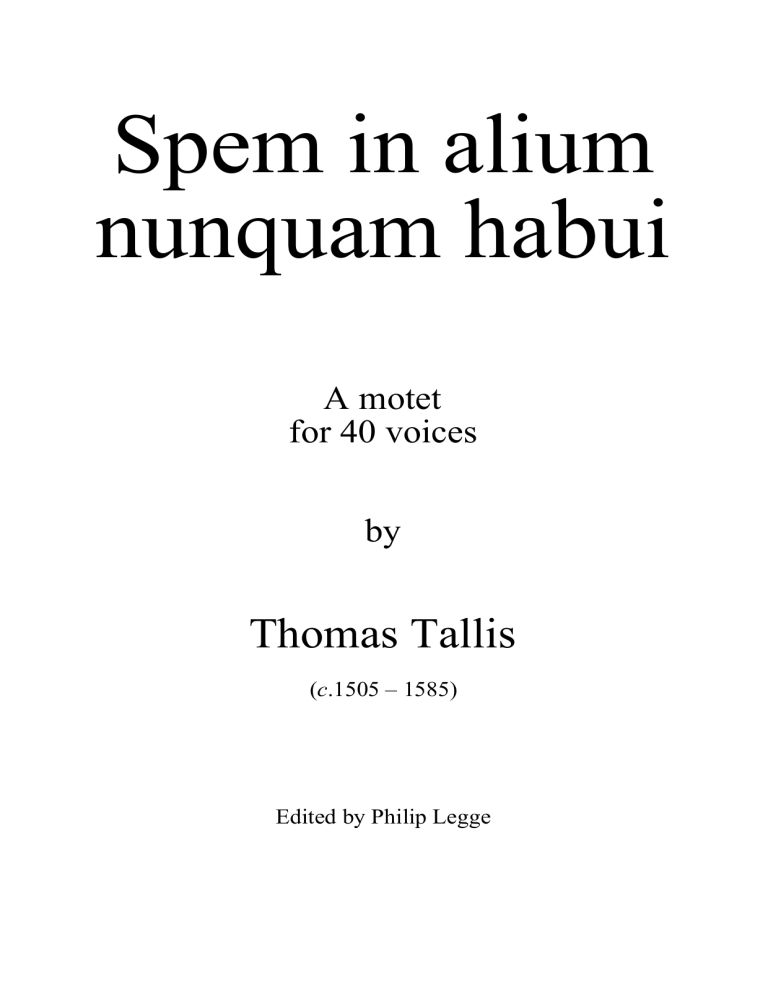
Spem in alium nunquam habui A motet for 40 voices by Thomas Tallis (c.1505 – 1585) Edited by Philip Legge Notes Except for the unplanned visit to London in June 1567 by the Mantuan gentleman, diplomat and composer Alessandro Striggio senior, who came bringing performance parts of his 40-voice Missa sopra Ecco sì beato giorno, it would seem otherwise unlikely Thomas Tallis would have received inspiration for his own sublime motet in 40 parts, Spem in alium nunquam habui. The rediscovery of the mass by Davitt Moroney and his researches have confirmed most of the salient details of this story, in particular verifying the account of one Thomas Wateridge, a law student at the Temple: In Queen Elizabeth’s time yere was a songe sen[t] into England of 30 parts (whence ye Italians obteyned ye name to be called Apices of ye world) wch beeinge songe mad[e] a heavenly Harmony. Allowing for 30 parts being an error, either deliberate or unintended, then the mass undoubtedly received a performance in London during Striggio’s fortnight-long stay, probably in a non-liturgical context; it now seems rather less likely that he performed his extant 40-part motet Ecce beatam lucem. Striggio’s diplomatic business, which primarily involved petitioning the Holy Roman Emperor on behalf of Duke Cosimo de’ Medici, had in 1566 taken him from Florence to Vienna via the Gonzaga court at Mantua, then on to the Wittelsbach court in Munich via Brno, and by April 1567 to the Valois court in Paris via Innsbruck and Augsburg, before he seized his initiative to visit England. The mass (with its Agnus Dei expanding to 60 voices) had been performed at least twice on his tour, once liturgically before Duke Albrecht V in Munich, and privately after dinner for King Charles IX at a château outside Paris; only the departure of the imperial court from Vienna had prevented a performance before the Hapsburg emperor Maximilian II. Striggio’s gift of a six-voice madrigal D’ogni gratia et d’amor, later placed at the head of his second book of six-voice madrigals, fittingly attests to his meeting with Queen Elizabeth I, and Wateridge’s account likewise to an English performance making “a heavenly Harmony”. The anecdote goes on: The Duke of _______ bearinge a great love to Musicke asked whether none of our Englishmen could sett as good a songe, and Tallice beinge very skilfull was felt to try whether he could undertake ye Matter, wch he did and made one of 40 partes wch was songe in the longe gallery at Arundell house Arundel House was the London home of Henry FitzAlan, the 19th Earl of Arundel, and his son-in-law, Thomas Howard, 4th Duke of Norfolk, was probably the musicloving nobleman mentioned. FitzAlan was moreover considered to be the leader of the English Catholics at the time, and had held high office under four successive Tudor monarchs, being Privy Councillor and Lord Steward of the Realm under Elizabeth, before retiring from office in 1564 and undertaking a fourteen-month visit to Italy from 1566 to April 1567, which plausibly might have resulted in an encounter with Striggio, and an invitation for him to visit London. FitzAlan possessed the largest musical establishment outside the court, and in 1556 had purchased from Mary Tudor the fabled Nonsuch Palace, England’s largest Renaissance building, as his country residence. The music collection held in the library there is known to have been extensive, as in 1596 a catalogue was drawn up, which happens to reveal the existence of a score of Spem in alium. Nonsuch also possessed an octagonal banqueting hall with four first-floor balconies, which intriguingly suggests the architectural features that Tallis incorporated into his composition: it is conceivable he designed the work to be sung not only in the round, but perhaps with four of the eight choirs singing from the balconies. Of Tallis’ motet, it: [...] so farre surpassed ye other that the Duke hearinge of yt songe, took his chayne of Gold from of[f] his necke and putt yt about Tallice his necke and gave yt him (wche songe was againe songe at ye Princes coronation). — “By Ellis Swayne at my Chamber ye 27 Novr 1611” The Duke of Norfolk was imprisoned in the Tower from October 1569 until August 1570, and then again in September 1571, being subsequently executed in June 1572 owing to his participation in the Ridolfi plot, which would suggest a dating of Tallis’ motet to around the year 1570, and its first performance during the thirteen months of freedom enjoyed by the Duke. While no manuscripts of the original Latin motet (such as the copy held at Nonsuch in 1596) are currently known to exist, copies of the version sung at the coronation do. Retexted as an English contrafactum, the motet was performed, firstly for the investiture of Henry, Prince of Wales, on 4 June 1610; and after his decease, the ceremony and the motet were repeated on 4 November 1616 for his younger brother, the future King Charles I. The text sung was: Sing and glorifie heavens high Maiesty Author of this blessed harmony Sound devyne praises With melodious graces This is the day, holy day, happy day For ever give it greeting Love and joy hart & voice meeting: Lyve Henry [Lyve Charles] Princly and mighty Harry lyve [Charles lyv long] in thy Creation happy. The editors of Tudor Church Music in the 1920s did not have access to the earliest known source, Egerton MS 3512, a large full score dating from the early 17th Century and rediscovered in 1947, but instead used a slightly later manuscript set of parts from the Gresham College Library (now in the Guildhall Library, G. Mus. 420). These two manuscripts are the only extant copies known to originate from the seventeenth century, or earlier. The Egerton full score was not copied in choirs, but first all of the sopranos, numbered by the scribe 1, 6, 11, 16, 21, 26, 31, 36; then the altos, numbered 2, 7, 12, 17, 22, 27, 32, 37; and so on for the other voices, suggesting eight identically-formed choirs of five voices (whereas Striggio had employed five non-identical eight-part choirs). An unfigured thorough bass appears in the middle of the full score, after the 20th voice. The five voice types (described in this edition as soprano, alto, tenor, baritone, bass) possess similar ranges in each choir and are notated in the set of G2, C2, C3, C4, and F4 clefs. Performance at a higher pitch than as written is possible and might have involved an alternate voicing of each choir as treble, mean, contratenor, tenor, and bass. There are several noteworthy additions to the Gresham MS: on many of the individual pages for each voice part, the scribe copied out the original Latin words (taken from the Sarum Breviary); the unfigured thoroughbass following the 20th voice is denoted “for ye Organ”; and at the end of the 33rd voice the scribe wrote “This song was first made to a lattin ditty by Mr. Tho: Tallis; but who put in the English ditty I ame altogether ignorant off.” This statement, amongst other evidence, supports the idea that the Egerton MS was the original copy of the English contrafactum, and the Gresham MS was copied from it some years later. Orlando Gibbons, John Amner, and Thomas Warwick have each been put forward as putative authors of the Egerton MS, however these speculative guesses originate from long afterwards; a more recent claim for the composer John Ward has been rejected on the basis of comparisons with identified holographs. The Egerton MS bears an inscription on the last folio, “Mr. Thomas Tallis, Gentleman of King Henry the Eyghts Chapel, King Edward, Queen Mary & of her Maiesties that now is, Queen Elizabeth, the maker of this Song of fourty parts.” This is taken to infer the author of the contrafactum copied the annotation from a manuscript dating to Tallis’ own lifetime, even though the contrafactum itself must date from the early part of the reign of James I, or no earlier than 1603; the Gresham MS also copies this text, but omitting the clause referring to Elizabeth as “her Majesty that now is”. For the text underlay Tudor Church Music used another manuscript (Royal Music MS 4 g. I) bearing the Latin text, but as this dates from the eighteenth century it probably does not preserve the word placement of Tallis’ original; the editors themselves noted the underlay “is in places so perverse that it appears like an attempt on the part of an unknown editor to fit the Latin words to the English adaptation.” Hence the editor of this new edition has dispensed with this text underlay and supplied his own. Text aside, the music is a direct transcription of the Tudor Church Music version, which as described above used the Gresham MS as its principal source; the collation of the two manuscripts indicate the scribe of the Gresham MS attempted to add some accidentals according to the rules of musica ficta. Though the earliest manuscript has many fewer accidentals than this edition, it is not inconceivable that the work was indeed sung with many more than are included here. Although the organ bass line cannot be shown to have originated with Tallis, it was possibly conceived in emulation of Striggio, who did utilise a continuo bass in his mass and motet, and so may be included or omitted in modern-day performances. Musically, the motet is a tour de force on many levels, not least for Tallis’ masterful exploitation of his choirs’ spatial distribution. If the choirs are arranged in circular fashion sequentially by number, then the music “rotates” through the opening points of imitation on Spem in alium nunquam habui (choirs I to IV) and Præter in te, Deus Israel (choirs V to VIII). After a short interjection from choirs III and IV (which functions antiphonally as “decani” to the “cantoris” of choirs VII and VIII) Tallis completes the circle with the entry of the final bass voice of Choir VIII; shortly afterwards, at the fourtieth breve of the work, all forty voices enter in the first of a series of massive welters of sound, which has been described as “polyphonic detailism”. The next imitative section which follows at qui irasceris et propitius eris reverses the direction of rotation as new voices enter against varied countersubjects in the parts already established. Tallis also manages to combine the exchanges between choirs in four different antiphonal arrangements, by amalgamating the singers in four groups of two choirs (as hinted at above), so antiphony can pass back between both “north” and “south”, but also between “east” and “west”), but also as two groups of four choirs (ie one massive 20–voice choir against another) which can be arranged in two different ways (north and west versus east and south, or north and east versus south and west). After the most intricate chordal passage so disposed between the various choirs, Tallis contrives the entire choir of 40 voices to enter as one after a pause, “upon a magical change of harmony”. With the words respice humilitatem nostram Tallis ends with the most strikingly unhumble polyphonic passage yet heard, framed by the strong harmonic rhythms of the ensemble. The view that this might be Tallis’ opus magnum is intriguingly suggested by Hugh Keyte’s observation of a possible numerological significance in the work’s duration being exactly 69 long notes: in the Latin alphabet, TALLIS adds up to 69. Philip Legge, Melbourne, November 2004, revised to February 2008 Copyright © 2004–08 Philip Legge, for the Choral Public Domain Library: http://www.cpdl.org/ Edition may be freely distributed, duplicated, performed, or recorded. Spem in alium nunquam habui Soprano I Alto I Tenor I Baritone I Bass I Soprano II Alto II Tenor II Baritone II Bass II Soprano III Alto III Tenor III Baritone III Bass III Soprano IV Alto IV Tenor IV Baritone IV Bass IV Soprano V Alto V Tenor V Baritone V Bass V Soprano VI Alto VI Tenor VI Baritone VI Bass VI Soprano VII Alto VII Tenor VII Baritone VII Bass VII Soprano VIII Alto VIII Tenor VIII Baritone VIII Bass VIII Spem Spem in a in a li um li nun um nun quam ha quam ha bu bu i, i, spem in a in Spem in Spem spem a Spem in a Thomas Tallis (c.1505–1585) in li li um nun li a a um Spem quam um li nun li in ha 2 7 um um I III IV V VIII VII VI ha bu i, II nun quam, nun quam ha bu i, nun quam ha bu i, nun quam ha bu i, a li um quam nun bu quam ha Spem spem in a bu in Spem spem spem in ha i, i, a li li um spem um nun in a nun li in a a quam in Spem bu Spem i, li a in in a li li um um nun nun quam um spem in a li quam li um nun ha bu um ha nun in quam a ha li um nun ha i, quam bu spem nun quam Spem bu i, ha i, nun a in quam ha ha bu quam nun um bu ha bu i, ha bu i, a li um nun ha quam quam bu spem i, bu in Spem nun quam ha i, i, a li Spem in 13 i, li I II um, ha bu spem spem i, um spem nun quam ha in a a li um III IV V VIII VII VI Spem li nun in in a bu i, um nun quam a li Spem li a a li li um in ha in um quam li um, spem in a li um nun um a nun spem ha nun in in a li li bu nun in um 3 quam nun in a li i, a nun a quam nun ha ha bu i, quam quam spem in um i, quam ha a nun ha ha nun bu spem quam um li quam nun li um in a spem in a li um, li um um nun quam ha spem bu i, quam, nun quam ha li bu i, um nun quam ha spem in a li um bu i, quam ha a um li in spem a spem bu i, spem in a in a li um, spem quam ha bu i, in a li um nun bu i, spem in in bu ha nun quam Spem i, bu quam ha li Spem bu bu spem bu bu ha ha i, spem in nun a i, ha i, a quam i, spem in a li um nun in Spem in a Spem li ha ha i, quam bu li quam a um bu ha nun i, in um in a li nun in bu a in a li um nun quam ha quam um spem in um bu a li um nun spem li i, in bu li li um spem a a spem in um nun bu quam ha nun i, ha um um spem in a li i, spem in bu i, bu spem in i, bu spem quam a nun quam ha bu um a li 4 19 i, spem ha bu i, nun quam ha nun quam nun quam quam, ha bu i, i, I II in a spem ha ha spem spem in a li um, in a li um nun quam li um ha spem bu i, li um nun quam ha ha bu li um i, III quam IV um V VI VII i, ha bu nun i, ha VIII Spem quam bu bu quam nun in a in bu i, in a nun bu in a i, i, spem bu quam ha li um li um in bu i, i, quam li a ha li um, quam in i, spem ha spem in a li um nun nun quam, in a li um nun quam ha bu nun in a li um nun quam ha bu quam, um nun quam, nun quam ha bu i a li um nun quam nun quam ha bu i, spem in a nun li um li um spem in a li um nun quam ha bu i bu i, um nun quam ha bu i li um, nun bu ha ha li a bu nun bu i, um spem a i, nun bu in spem um nun in a spem in spem ha spem quam li a li nun quam ha bu a i, li um i, spem in a li um nun quam ha bu i, nun quam ha bu in um ha in a spem i, spem in a li spem in i, spem in a i, li bu ha in quam a a li ha li bu um, li bu a bu i, i, um bu i, li i in spem ha um in um in a um li nun nun um quam ha i i bu bu i nun quam quam, ha quam ha bu i quam ha nun quam ha i nun quam ha i, bu spem in a li nun quam ha i, bu spem in a li um nun quam spem in a nun quam ha bu i a Præ ter li in Præ te, in Præ ha bu te, ter in Præ De ter um… Præ 25 I IV ha bu i i in a li um um, ha bu i, ha bu i, us te, V ter li um… Is in ter VI VII VIII in te, us spem in a De De Præ ra li um Is te, nun quam, nun quam nun quam, nun el, ra us Is us Is ra ra in te, De us Is Præ ra el, in Præ Præ us Is el, ter in præ ter te, De ter in ra el, in i in Is te, De us te, De præ te, ter us ter te, præ i el, ter bu bu quam ha nun quam… el, De ha De bu i ha bu i bu i II III i ra De in te, ter in De Is us Is Is te, us ra ra us el, De us Is el, Præ Præ Præ ter in ter in ter in Præ te, el, el, De ra us Is ra Is el, De us Is ra el, Is ra el, ra te, De us Is ter in De Is ra el, us præ 5 te, Præ te, ter De Præ De ter in præ te, us Is ter ra in te, ra in ter in De el, præ te, 6 31 I ter in te, el, ra el, te, De præ præ præ el, VI us præ De te, us VII ter VIII præ in De us Is in præ ter in Is ra in præ te, ter us ter in te, De te, te, us in el, us el, De te, te, De præ ter us Is us Is in in te, te, Is ra De ter in te, us us Is Is ra in te, ter præ De el, ra el, Is us ra ter in te, Præ Præ præ præ præ præ præ te, De præ ter in Præ ter in De te, ter te, el, ra el, præ præ præ in te, De te, ter in te, ter in te, ter in te, De ter in te, ter in ter in te, ter in te, ter in ter in te, us De in te, De us Is us Is us el, De Is us Is Is te, De ra De Is Is us te, ra el, el, ra ra ra el, el, ra ra el, us De in ter us De in ter el, ra Præ ra el, us, Is us De us Is ra el, Is ra el, el, præ us præ præ De us el, ter Is ra el, ter præ De De De Is ra el, ter ra ra el, Is el, De Is in us ter te, ra in ra ra el, De in te, De Is præ ter præ us ter Is ter præ V IV III II el, 37 Is III us De De us IV V VI VII VIII us Is us Is Is Is Is el, el, ra el, ra ra Is ra ra el, el, el, el, el, præ præ præ præ præ præ ter in ter in ter in ter in De te, ter in te, præ præ ter Præ præ te, ter in De De præ præ præ præ præ præ præ præ præ ter in te, ter in te, ter in te, ter in te, præ præ præ præ præ præ præ præ præ præ præ præ us Is Is in te, De Is ter in te, us Is us us us Is Is ra te, ter in te, ter in te, ter in ter in ter ter te, ter in in De te, præ præ te, ter in ter in te, ter in ter in te, ter in te, ter te, in ter ra el, el, ra el, De De ra præ in De us Is Is Is us præ præ ter De el, præ el, ter ter Is ter in ra in us in te, ra el, De ra ra Is ra el, Is ra el, in te, us Is præ te, te, De præ in ter De in us De Is us Is De De ra us us te, Is ra us Is præ Is us el, in Is ra De us præ ter ra te, ra præ te, De præ Is Is De in Is in in ra us De in el, ter te, el, De el, te, ter ra Is te, De ra us De el, ra el, De us ter us te, præ us Is ra in Is ra el, el, in te, Is us us Is ra el, De ra præ ra te, us De De ter Is us el, el, Is De us Is De præ us in el, ter ter Is ra us ra us in el, præ Is præ te, in te, te, Is us præ te, ra De ter in ra el, ter in in us, te, ter te, De us De ter De in De te, te, De us Is te, ra el, us præ Is ra el, us Is ter De ra Is ra el, ter in Is te, te, us te, præ in te, ter De in in te ter in De in ter De in ter us us De ter te, in ter De us præ ra te, in De præ De ter præ us De te, in ter in Is Is ra el, us De præ præ De præ te, ter in ter præ in te, ter præ te, De us te, De us, te, præ ra el, el, præ ra us ra Is Is De us De us ra ra us Is De De us II 7 I te, De ra 8 43 ra el, ter in in te, ter I II te, in Is ter Is us De IV ter el, in ra De in te, præ el, us ra Is ra el, ra el, ter VI el, De el, us el, te, Is ter VIII in in ra el, Is ra el, te, us ra De ter te, us, præ te, De De Is el: De De el: De us Is De ra us el: ra De us Is el, ra el: el: Is Is Is us Is De ra ra ra De ra i us ra Is qui ra el: ra ra el, De ra el: qui i qui ra i sce us Is ra ra sce ris sce ris i ra ra ris i sce et el: ra sce pro el: qui qui ris el: Is De us ra el, qui Is el: ra el: el: el: ra ra el: Is el: el: el: Is Is Is ra Is Is el: us ra ra el: el: Is ra el: Is ra el, ra Is el, ra el: us el: el: ra Is us te, us el: us ra us Is Is ra el: us el: ra De us us Is us us De ra ra el: Is ra el: us te, De qui te, ra us De ra Is el: ra te, el: De el, us Is el: ra us el: Is in Is el: ra el: De el, ra ra us te, De te, De in el, ra Is De ter in De in ra te, Is in te, te, us ra Is ra Is ra el: ra el: in te, De us Is ra el: Is ra el: el, us el, Is te, in De in te, us in in præ Is Is in Is VII præ ter el, ra el, præ ter in ter el, in us V el, ter Is De te, te, ra De us Is Is in Is us De Is De ra te, us Is ra Is Is ter in us el, De el, us el, te, Is De te, te, us in in ra ra Is ra el, præ ter præ Is te, De us De in præ us Is te, De us Is el, III te, De ra in te, el, el, ris pi i pro ti pro pi pi us qui i et pro ra et et ti et pro pi i ra us qui sce qui ris, ti us sce ti e ris, e 49 I us e pi ra ris, ti us i sce ra ra sce VIII ris, qui i ra i ra qui ris ra i sce ris, sce ris, i ris, qui sce ra ris et i i ra ris, sce sce ris pro pi et sce qui pro ris et pro pi ti e us qui i qui ra i e ris, ti us ra i ra sce ris, ra sce ris, qui ris ra qui i ra sce ris et i ris, e ris, ra sce pro et sce ris et pro et ris, ris, qui ra sce ris i i sce ris, ra et pro pi ti us e ris, qui i et pro pi ti us e pro e pi ti us ris, sce ris et i qui qui ra sce ris, ra sce ris ris, i e e pi ti us ris et pro pi us e ti i ra sce ris e ris, et pro pi ti us e qui i ra qui i ra sce ris et pro pi ris, sce ris, ti us i qui qui qui qui 9 VII VI V IV III II pi ti 10 55 I i et ti pro sce ris et et pro pi ris et pro pi pro pi pi VII us VIII et ti us pi e pro e i e ris, e ris, ris, ris, ra sce i ti pi et i ra pro pro ra us ra sce ris ris pi ti ti us us i ra sce sce ris, sce qui qui qui i ris, et ris ris et sce pro ti us pi i ra sce ris e ris, pro i ra ra et ris et sce pro pro e pro pi e ti us ris, e ris, pi et pi ti us et pro pi ti us, qui sce ris et pro pi ti us e pi ti et pro pi ti us e ris, us e ris, e ris, et i et ris, pro ra ris, ris, et i qui qui qui qui qui us, pi ti us ra ti us pi ti us e e ti us ti us e qui ti pro sce ris qui i ra sce ris et pro pi us e ris, ra sce ris, i qui pro pi VI V IV III II 61 e ris, III pi ti pro pi ti us, et ris, IV ris, V ra VIII VII i et et pro qui i pi pro sce qui pi ris ti i us et pro ra sce ris pro pi ti us ti us et pro ris pi ti us e ra sce pro pi ti us e ris, et pro e et pro us ris, qui i ra sce ti us e ris, e ris, et ti us pro pi VI et II us, pi ti ris et pi pro pi ris, ti 11 I et ti us e pro pi ti ti e us ris, us e et o et et et o et o et et et o e ris, e ris, o mni ris, ris, ris, mni a, e mni pi ti us ris, o ris, ris, mni o mni a o mni a ris, e ris, e ris, e e et pro pro pi ti us e et pro pi ti us e us pi mni mni 12 67 a I pec pec a a a a II III IV V VI pec pec ca ca VIII VII ca pec ta ta ta ta ho ca mi mi ta ho num, ho mi num, ca ca ho pec ta ho mi ho num, mi mi et et o num, et o o et o et et o et et o et o et o mni a o mni et et et et o et o et o ho mni ca ho ta a pec mni a pec ho num, ta a pec ca o et o pec o pec ca ca et ta pec pec ta ho ta o ca ho o pec ta mi ho mni a ca ta ca ta ta ho mni ta mni mni a pec a pec mi a ho a et mni mni a a pec ca num, ca pec mi num, ta ho ta ca num, a ho mni ho num, ta mi num, mi num, o ho et ta ho ta mi num, et ta ho pec mi et num, ho mi num, pec ca pec ca ta ca mi num, ca ca pec et pec ho ca ho o ho mi pec mi num, pec ca et ho mni a ta pec ca ta pec ca ta pec ca ca mi pec ho mi num, ho ho pec pec mi num, ca mi num, mi num, ca mi num, pec ta ca mi num, o mni a ta ho mi ta ca ta ca ta ho ca ta ta pec et num, et ca mni a ta pec ca pec pec o ca pec ca mi num, pec ca ta pec ca ho ca mi num, ho num, mi num, pec mi ho a mi num, ta ho pec mni ho mi num, pec ta ho mi num, pec pec ho ta ta mni a mni a mni a pec ca et o ta pec mi pec ho ho mi num, ho ho o num, mi num, ca mni a pec ca ta o ca et ca pec ca ta ho mi num, ta ho o mni mni a, et o a mni mni ho et mi ca pec ca o mni a, mi num, ca ho a pec ca ta et o mni a pec ca et ta ca pec a mni a mni a o mni et o pec mni a o et a mni a o mni a et a et o mni mni a, o pec ho mi num, pec ca ta pec ca ho mi num, ta o pec ca ho mi num, mni a ta o mni a et o mni a pec mni a pec ca ho ta mi o a o mni a et et o ta, mni ca o mni a mi num, pec ca ta mi num, pec ca pec o o ta a et a pec mni mni pec ca et a o et pec mni a mni et et o et a mni et et et et mni o mni a et num, o o et et mni a o num, et mi ta o ta, pec pec ca ta ta ho ho mi num, pec ta ta ca pec ca ta ca ta ho mi num, 73 I ca ta pec pec II III IV V VI ca ta ho ca ca ho mi num, o mni a pec ca num, ca o mni a mi num, ho mi num, ho mi num, pec mni a pec ca mi num, ho ta pec ca ta mi num ho mi num ho mi num ho pec ho mni a ca pec ca pec ca ho mi num in in ho mi num ta ho mi num pec ca ta ho mi num in pec ta pec ca ta mi ca ho pec ca ta ta ho ho mi mi num, ca ta ho mi ho ta mi mi num, ho ho mi ho ho ho in in in in in in in mi num num num mi num o ne, ne, o in in tri ti bu la tri bu bu in tri bu la ti o in tri bu la ti in in ti o ne tri di mit tis, bu la ti o ne ti o tri bu la tri bu la di ti o ne tri bu la ti o ne di tri bu la ti o ne tri o ne, di la ti ne o o di ne bu la ti o ne bu la ti o tri tri la di in mit tis, di mit mit tis, in tri in in in mit mit ne di mit tis, di mit in tri bu la ti o di mit tri tis, in tis, tri tri bu bu la bu tri tri bu la bu la tri tis, tis, bu tri bu la in tri bu la in ne tis, di mit tis, mit tis, di di tis, mit tis, mit tis, mit tis, di mit di mit tis, ne ne in in tri mit tis, di tis, o ne, tri ne, ne ne 13 ne ne, la ti o bu la ti o ne ne, o ne, ti o ne o ne ne ti ne, ti bu la tri bu la ti o ne in tri bu la ti o ne in tri bu la ti o ne tri bu la ti o tri bu la ti o tri bu la ti o ne, tri bu la ti bula ti o ne, in tri bu la ti o ne di mit in tri bu la ti o ne in tri bu la ti o ne, in tri bu la ti o ne di mi num mi num tri in mi bu tri in mi num num in in bu la tri bu la in tri bu la ti tri bu la ti o bu tri in tri num ho mi num in in num num ho in mi mi num mi num, in mi num ho mi num ho mi num mi num mi num mi num ho mi num num tri in mi num ho num ta num ca num ho mi mi num ho ho mi num ta mi num ho mi num ho ta ta ca ho ho ho ho mi num, ho mi num mi num, ho ta la ti tri bu la ti o tri bu la ti o ne, tri bu la ti o ne, tri bu la ti o tri bu la ti o in num ti o ti o ne, tri bu la ti o ne, ta ho mi num, mi mi num tri bu la tri bu la in in ta mi num, VIII pec ca ta ca ta ho mi num, ho mi ho in ca ta in in ta pec in mi num, pec ho ho mi num, ho ta ho ta ca o mni a pec ca ta ho ta ho mi num, pec ca ta num, ho mi num, VII mi num, bu ti 14 79 ti o bu la ti o ne la ti o ti o ne la V VI la ti ti o ti o ti o la o VII ti ne ne VIII o o di di mit in tri bu in bu in tri bu la in tri bu la ti bu la ti o ne di mit tri tis, ti bu la la ti o ne ti o ne di mit ne o tis, ne tri o ti mit o la in bu la ti ne la ti o bu la ti o ne di mit tis, ne di mit tis, di mit tis, di mit ne di mit tis, ne di mit tis, ne di mit tis, di mit tis, di mit di mit tis, tis, ne di mit tis, ne bu in tri tri in tri in tri in tri in IV III II I tis, bu di di tis, ne di mit mit ne di mit o mit di tis, mit la ti bu la ti o ne o ne di mit tis, tis, tis, mit in tri bu la ti o tis, di mit tis, di in tri tis, tis, di ne mit tis, mit tis, di tis, di mit mit di mit di mit di di di di mit mit di mit di mit mit 85 di di di di di II mit tis, di mit tis, di mit tis, di I di di mit di mit mit mit mit tis, mit di tis, di mit tis, tis, di tis, mit tis. di mit mit di di mit tis, mit tis, di di tis, tis, tis, tis, IV tis, V VI VII VIII di mit di di di di di mit di mit tis. mit tis, di mit tis, di mit di mit tis, mit di mit tis, di mit di di mit tis, di Do Do mit tis. tis. Do Do ne De ne mi ne tis. Do Do us, Do di mit mit tis. tis, mit De De di tis. mi ne mi ne mit De mi ne De mi ne De Do Do Do us, us, us, Do Do Do Do Do Do Do mi ne mi ne mi ne mi ne De mi ne De mi ne De us, mi ne Do mi ne De us, Do mi ne De us, mi ne Do mi ne mi ne De De mi ne mine Do mi ne De us, Do Do Do tis. us, us, De us, De De us, tis. us, De mi ne tis. mi ne mi ne 15 us, tis. us, mit tis. di mit mit tis. di tis. Do mi tis. mi De us, mi ne Do De mine Do mi ne De us, Do tis. di Do tis. mit mit Do di tis. di tis, De mi ne Do mi ne De us, Do mi ne De us, tis. Do De us, mi ne mit tis. Do tis, tis. tis. tis. tis. tis. di mit di di tis. mit mit di mit mit tis. tis, tis. tis. mit mit tis. di di mit tis. di mit tis. di mit tis, mit tis, mit di di tis. tis. di tis. mit mit di mit mit mit mit di di di mit mit tis, di di tis. tis, III mit tis, di tis. tis. mit tis, di mit tis, di mit di tis, tis, di mit tis. tis, mit tis, di di mit di mit tis, mit di tis, mit us, us, us, us, mi ne mi ne 16 91 De IV V VI VII VIII mi ne De mi ne mi ne De De us, mi ne De us, us, us, us, us, Do Do Do Do Do Do Do tor mi ne De De mi ne mi ne De mi ne De mi ne De mi ne De us, us, us, us, us, et ter ter a tor Cre a tor Cre a tor Cre Cre Cre Cre a a a tor tor tor a tor Cre a tor Cre a tor cæ cæ cæ cæ cæ cæ cæ cæ Cre Cre Cre Cre Cre Cre Cre li et ter li et ter et ter li et ter li Cre et li ter ræ, ter ter ræ, ræ, ræ, Cre a tor a tor Cre a tor Cre a a a a a a tor a tor Cre tor cæ tor cæ tor cæ tor tor ræ, Cre ræ, a tor a tor a tor ræ, ræ, et ter li ræ, ter li et ræ, et li cæ li et ter cæ et li a tor Cre a tor Cre a tor Cre a tor Cre a tor Cre ræ, tor a ræ, Cre ræ, Cre ter ræ, li us, ter De mi ne et li et ræ, ræ, ter us, et li De ræ, li et ter ræ, cæ li et cæ li et ter ræ, cæ li et ter ter cæ mi ne et tor us, Do De us, mi ne Do mi ne De us, cæ Do tor a li cæ tor a cæ Cre Cre cæ Cre tor tor a a tor a tor Cre a a Cre a Cre Cre Cre us, us, us, us, us, De us, De us, De us, De us, De us, De us, Do De De De mi ne Do mi ne De Do De mi ne De us, III mi ne Do Do II Do Do I Do cæ cæ li cæ li cæ cæ 97 III cæ cæ cæ cæ cæ cæ IV cæ cæ li et li et li li et li li et ter VI VII et ter et ræ, ter ræ, ter li cæ li et et ter ræ, ræ, ter et ter et ræ, et ter li cæ ter ræ, ter ræ, et li ter ter ter et li ter ræ, et li VIII li et et cæ ræ, li et ræ, ter ter et ter et ter et ter ter ter ter et ter et ter et ter ræ, ræ, ræ, ræ, ræ, ræ, ræ, ter ter ræ, ræ, ræ, ræ, ræ, ræ, ræ, Cre a Cre a Cre a tor, tor, tor, Cre a tor, Cre a Cre a tor, 17 cæ cæ cæ ræ, cæ tor, Cre a tor, Cre a tor, cæ li tor Cre a Cre a cæ li tor tor, Cre a cæ li tor, Cre a tor Cre a cæ li tor, Cre a tor Cre a tor, Cre a tor Cre a tor, Cre a tor cæ li Cre a Cre a tor cæ tor, Cre a cæ li tor, Cre a tor tor, Cre Cre a tor, Cre a tor, a Cre a cæ li et ter tor ræ, Cre a tor cæ li, et ter ræ, cæ Cre a tor, Cre a cæ li et ter ræ, cæ tor Cre a tor cæ li et ter ræ, cæ Cre a cæ cæ tor li et ter ræ, Cre a cæ li et ter tor ræ, Cre a Cre a a tor cæ li et ter cæ li et ter ræ, tor cæ li et ter ræ, Cre Cre a tor Cre a ræ, tor ræ, Cre a ter ræ, ræ, et ræ, et ter ræ, et li et ter ræ, li et ter ræ, cæ li et li et et ter ræ, et li et ter et ter ræ, li et cæ V ter ræ, cæ II Cre a tor, I tor cæ li et ter ter et ter et ter li et ter et ter et ter ræ, ræ, ræ, ræ, ter ræ, ræ, et et ræ, ræ, Cre a tor tor Cre a Cre a tor Cre a tor Cre a tor Cre a tor Cre a tor Cre a Cre a Cre a tor tor 18 103 I li et ter ræ, li et ter ræ, li et ter ræ, li et ter ræ, li et ter li ræ, Cre Cre Cre a a Cre a tor et li cæ li cæ li cæ li et cæ tor tor ter et ter et ter ræ, ræ, ræ, et ter ræ, ter ræ, cæ li et ter ræ, cæ li et ter ræ, li et ter et ter cæ li cæ li cæ cæ li cæ li et ter li et et ter ter et ter ræ, ter ræ, ræ, ter ræ, et ter Cre Cre ræ, ræ, a ræ, ter et a a tor cæ ter li et ræ, cæ li et cæ li et et ter ræ, ter re ræ, re ter ræ, re re re re ter et ræ, ter ræ, ræ, ræ, ræ, ræ, ræ, ræ, li et et ter ter cæ li et ter cæ li et ter cæ li tor cæ li et ter li ræ, ter ræ, et ræ, tor a tor cæ Cre a tor Cre a tor cæ li et cæ ter Cre ter Cre a tor cæ li tor cæ li et cæ li ræ, Cre et ter Cre ræ, et a tor Cre a tor Cre a tor ræ, et et ter ter li et ter ræ, et ræ, ter li et ræ, ræ, cæ cæ li et ter ræ, cæ li et ter ræ, cæ et li cæ li et ter ræ, cæ li et ter ræ, cæ li et ter ræ, li tor cæ cæ cæ li et ter ræ, cæ li et ter ræ, et ter cæ li, cæ li et Cre a ter ræ, tor tor tor tor Cre a tor Cre a tor Cre a tor tor tor Cre a cæ li tor Cre a cæ tor Cre a cæ li tor Cre a tor Cre a tor cæ li Cre a cæ li tor a Cre a Cre a Cre a Cre a VIII VII VI V IV ter III et ræ, Cre a li et ter ræ, li et ter ræ, II ræ, re re re re re re re re re re re re re re re re re re re re re re re re re re re re re re re re re re 109 spi spi spi I spi spi spi III V VI VII ce ce, spi spi VIII spi spi spi spi spi spi spi spi ce ce ce spi ce spi spi spi spi spi spi spi spi spi spi hu ce, ce mi mi ce, ce li li hu hu tem ta mi mi ce ce ce, ce, ce, ce, ce, ce, spi ce, spi ce, spi ce, spi spi ce, ce, spi ta li li hu no ta ta mi li ta hu mi tem, li hu tem no mi li hu tem no mi li ta tem no li hu stram, stram, hu mi hu stram, no stram, mi li hu stram, hu mi li ta tem no ta tem no ta no tem hu tem mi li ta tem no ta stram, li hu mi hu hu ce ce, 19 ce ce spi ce spi ce, ce ce ce ce ce ce spi ce spi ce spi ce spi ce IV spi ce II stram, 20 115 II tem, ta mi li ta III mi ta V mi li li VIII no tem, hu stram, hu tem stram, li mi mi ta li mi hu mi ta no tem hu mi mi hu hu tem ta stram, VII ta no mi li VI tem hu hu mi mi li li tem no li ta hu ta mi tem, li hu ta no stram, stram, tem no stram, tem li ta no mi li ta tem no stram, tem no stram, hu ta mi hu mi li ta tem, li ta tem no stram, mi li ta no no li ta tem tem no stram, no li ta hu mi li tem no stram, ta stram, no stram, no stram, tem tem no stram, ta IV hu hu I no tem tem no stram, no stram, no re re 121 stram, stram, I stram, stram, stram, II stram, III IV V VI VII VIII re spi re re re re re re spi spi re re re re re re re re re re re re re re re re re spi spi ce, spi spi spi spi spi re spi spi mi li mi li ce ce hu ce ce hu ce, re spi spi re spi re spi spi spi ce, spi ce ce re spi hu mi spi ce spi hu ce, spi li mi li ce mi ta hu li li re hu li ta hu tem no li no ta li ta ta tem no tem no mi no no stram, mi li li li hu hu mi ta li tem li ta hu hu ta no ta mi mi li li re tem, ta ta li ta hu stram, ce no li mi li ta hu mi li ta no mi tem li mi spi li tem li ta ta tem no stram, tem no stram, stram, mi mi hu stram, re ta tem, stram, re stram, mi mi spi hu hu hu no hu tem, tem mi hu spi ta no hu mi li mi li ta tem mi li ta tem no ce no hu mi tem ce, li re spi no hu tem no stram, no stram, spi stram, hu mi li ta ta hu tem, tem hu hu li ta mi li ta mi stram, hu tem mi hu mi hu stram, hu tem, tem no re stram, ta tem, re tem stram, ta li tem tem tem ce ta stram, ta mi ta mi li li mi spi ce ta li mi hu hu ce mi mi mi mi mi ce ce hu mi hu ce ce, hu re ce ce ce, ce tem hu ce ce ce, spi ce hu mi li ta tem, re ce mi mi li ta tem ce ce ce re ce, ta hu ce hu no li ta tem mi li ta tem hu mi li ta ta ce ce ce, spi hu spi hu hu ce spi spi ce ce ce spi spi spi spi ce, re re ce spi spi hu ce spi spi spi re spi re ce hu hu ce spi spi re re re re re spi ce ce spi re spi spi 21 ce spi re spi ce re spi ce, spi re re spi re stram, hu mi tem, tem, li ta li ta hu tem, mi li ta mi li ta hu hu hu 22 127 I II no no VI VII hu no stram, mi li ta tem no stram, li ta no tem no stram, no stram, re tem li ta V stram, hu no no mi mi stram, mi li li tem no ta ta no no tem stram, hu ta mi stram, li ta hu mi hu no li stram, stram, re ta stram, no no tem, tem no li li stram, ce, hu stram, no stram, no stram, ta ta no no no re spi no no stram, re mi spi ta no no spi ce no stram, no stram, no tem no stram, li re stram, stram, hu ta tem no li spi ce stram, ta tem ce no li mi mi spi spi tem mi li ta mi no stram, no stram, re hu mi li ta spi mi mi li ta li ce hu hu tem ce no li ta ta tem tem hu tem li ta re spi ce hu mi no stram, re spi re spi ce hu mi li ta tem, hu mi li ta tem no mi hu spi ce, mi li ta tem re no li ce hu no spi hu mi li ta tem, hu mi li ta tem no stram, no mi li no stram, ta tem stram, hu mi mi li ta hu mi li ta tem, hu mi li ta tem no ce hu mi li ta tem no spi spi ce hu mi li ta stram, hu mi li ta tem, re spi ce hu li mi ta stram, spi ce re no re spi ce hu mi li no ta tem hu mi li ta spi ce tem hu no hu li ta tem no li ta tem re spi ce hu stram, hu mi li ta hu no stram, no no no stram, tem re ce no ta stram, tem re ta no stram, tem re tem, li re stram, hu mi li ta tem no no stram, re spi ce spi ce re stram, spi hu mi li ta tem stram, no stram, no re spi ce, stram, stram, tem mi mi no stram, re spi ce re spi ce stram, re spi ce, no stram, re ce, spi re spi ce no stram, no stram, ce no hu stram, li ta tem mi tem li ta tem, stram, no re spi ce mi li ta tem stram, no stram, re stram, stram, ce tem li re spi spi spi ce hu mi li no stram, hu mi li ta stram, no mi mi hu hu tem stram, hu no stram, hu mi no re no stram, re tem no stram, stram, tem stram, no stram, hu mi li ta tem no stram, no stram, hu mi spi ce no stram, re spi hu ce mi li ta tem stram, no stram, re spi ce hu hu li ta no stram, re mi tem spi ce no no stram, re stram, no stram, no stram, hu mi li ta re no stram, no stram, spi ce no ce ta stram, stram, no stram, stram, re spi li no mi ta stram, re li spi ce hu tem tem VIII no re spi ce hu tem ta no stram, stram, no mi li ta tem stram, stram, mi re spi ce, no hu mi li ce no stram, no hu spi ce ta tem tem no no tem tem no stram, no no stram, stram, re stram, li ta re spi ce no stram, no stram, no mi li ta no tem stram, re spi ce hu mi li ta tem mi li no stram, ta tem hu mi li ta tem, tem, no stram, re hu mi li ta no tem stram, ce hu mi no li ta tem re spi stram, ce III IV no stram, stram, hu re re spi spi ce hu mi ce hu spi ce mi li ta tem hu stram, spi ce re hu mi li ta tem no stram, re li ta tem hu mi re hu spi ce ta tem, no stram, hu mi li ta hu mi tem, stram, hu mi li ta tem no stram, hu mi li ta hu tem, mi li ta no stram, re spi ce hu mi no tem stram, re li ta no stram, hu mi li re hu mi li stram, spi ce ta tem, hu mi li ta no stram, tem hu mi li no ce ta tem no stram. tem hu mi li ta hu tem, tem, no stram, hu mi li ta tem no stram, no stram, hu mi li ta tem no stram, no stram, stram, no stram, re spi ce hu tem no no stram, stram, re spi ce hu mi li ta tem stram, re spi ce hu mi li ta 133 I II III IV V tem, stram, stram, ta mi mi stram, VII hu stram, VIII hu mi spi li ta hu ce mi li hu hu mi li li mi no stram, no li no stram, ta ta ta li tem tem li li hu no no no re no stram, mi li no tem mi stram, li li no stram, no no no tem stram, no stram, stram. stram. no stram. stram. no li ta tem no no tem no stram. stram. no stram. no stram. stram. stram. hu stram. mi li ta tem no stram. no stram. stram. stram. no no stram, no no no stram, li ta tem stram. stram, no stram. stram. stram. stram. stram. stram. stram. stram. stram. stram. stram. stram. stram. no no no stram, no tem tem stram. stram, no stram, tem hu mi no no ta mi li stram. stram, ta no stram, no no no ta ta no hu stram, tem no stram. mi li ta tem no tem li no mi stram, tem mi stram, no hu tem stram, ta hu ta no ce no li no stram. no stram, spi li no stram. no stram. ta tem no stram, no no stram, tem stram, stram, mi stram. stram, stram. li ta no no tem no tem hu no stram, mi li ta stram, stram, no ce tem mi mi stram, tem tem mi ta stram, no no ta no hu hu ta tem ta tem stram, no no ta hu li stram, spi ta stram, mi mi li ce spi no tem tem no hu no tem, no stram, stram, ta stram, no mi li ta tem hu stram, li ta ta tem mi mi li mi li mi li ta tem, no mi hu no tem tem hu no ta no tem no tem ta ta ce tem hu ta spi mi li ta tem no stram, re spi ce hu tem, hu li mi mi ta no stram, li tem li li ta re re stram, ce li hu mi tem, VI hu hu stram. stram. 23 Bibliography and sources c'. This error was only noticed by the editor as late as February 2008. Egerton MS 3512, British Library, ca 1603–10, Text: Sing and glorify; incorrectly described by Thomas Tudway, 1718, as “ye original score of Mr. Tallis’s 40 parts Anthem.” Gresham MS, Guildhall Library G. Mus. 420, ca 1625, Text: Sing and glorify Royal Music MS. 4 g. I, British Library, ca 1800, Text: Spem in alium Thomas Wateridge, Commonplace Book. Manuscript Department, Cambridge University Library, MS.Dd.5.14, fol. 73v. Rev. H. Fleetwood Sheppard, “Tallis and His Song of Forty Parts.” Letter to The Musical Times 19, nº 420 (February 1878): 97–98. A.H. Mann, Preface to Thomas Tallis, Motet for 40 Voices. London: Weekes, 1888. Tudor Church Music VI, editorial committee P.C. Buck, A. Ramsbotham, E.H. Fellowes, S. Townsend Warner. London: Oxford University Press for the Carnegie United Kingdom Trust, 1928: xxxiii, 299–318. Bertram Schofield, “The Manuscripts of Tallis’s Forty-Part Motet.” Musical Quarterly 37, nº 2 (April 1951): 176–83. Philip Brett, Preface to Thomas Tallis, Spem in alium nunquam habui: A Motet in Forty Parts. Oxford: Oxford University Press, 1966. Revised from the plates of the publication in Tudor Church Music 6 (see above). Pamela J. Willetts, “Musical Connections of Thomas Myriell.” Music & Letters 49, nº 1 (January 1968): 36–42. Iain Fenlon and Hugh Keyte, “Memorialls of Great Skill: A Tale of Five Cities.” Early Music 8, nº 3 (July 1980): 329–34. Elizabeth Roche, “Tallis’s 40-Part Motet.” Letter to The Musical Times 122, nº 1656 (February 1981): 85. Denis Stevens, “A songe of fortie partes, Made by Mr. Tallys.” Early Music 10, nº 2 (April 1982): 177–81. John Milsom, “English Polyphonic Style in Transition: A Study of the Sacred Music of Thomas Tallis.” DPhil thesis, University of Oxford, 1983: i, 190. Ian Payne, “The Handwriting of John Ward.” Music & Letters 65, nº 2 (April 1984): 176–88. Hugh Keyte, Sleeve notes for Thomas Tallis, “Spem in alium”, Tallis Latin Church Music I. Compact Disc EMI CDC 7 49555-2, 1989: 9–12 Paul van Nevel, Sleeve notes for Thomas Tallis, “Spem in alium”, Utopia Triumphans, translated by Griffin Anderson. Compact Disc Sony SK 66 261, 1995: 17–18 Davitt Moroney, “Alessandro Striggio’s Mass in Forty and Sixty Parts.” Journal of the American Musicological Society 60, nº 1 (2007): 1–70. The two manuscripts have more substantial differences concerning the bass and tenor parts of choirs VI and VII. In the Gresham MS, the tenor parts of choirs VI and VII have been entirely swapped beginning at bar 122 and continuing to the end, with respect to Egerton. The situation regarding the bass parts of the same two choirs is rather more complicated, as the parts are not interchanged for their entire duration. At the foot of the first folio of the Egerton MS, a note explains that parts 30 and 35 (the numbering given to these two bass parts) have been somewhat confused: “The figuring of the 35 must be for the 30, but its was mistaking the figures” (sic). The first phrases of each part, from bar 28 to bar 33, are swapped; the next short phrase in the bass of choir VII from bar 37 to 39 is however not transferred to choir VI. The next two sections, from bar 40 to bar 56, and from bar 69 to bar 77, are swapped entirely. At bar 78 the first note in choir VI is in the other score doubled to a semibreve and transferred to choir VII, the remainder of the line continuing in choir VI after one minim’s rest. The short two bar entry at bars 86 and 87 are swapped, and thereafter in the 20-bar section involving pairs of choirs answering one another the parts are not exchanged, as choirs VI and VII are not grouped with one another in this passage. After this, the new sections beginning at bars 108 and 122 are once again swapped between the basses of choirs VI and VII in their entirety. Commentary As Brett’s 1966 edition of Spem in alium for Oxford University Press differed from the Tudor Church Music version of 1928 by having access to the previously unavailable Egerton MS, he removed various instances of ficta (accidentals) appearing in the Gresham MS that were not present in the earlier Egerton MS 3512, which he summarised as affecting the following notes: bar 35 · choir VIII soprano voice · symbol 4; 36·VIIIs·1; 98·Va·5; 105·IIa·3; 129·IVt·1. This is not however the end of the story, as the following accidentals, also occurring in Gresham but not in Egerton, were left to stand: 8·It·4; 12·Ia·2; 16·IIIt·3; 20·IVa·2; 22·IVt·2; 26·Vt·3; 33·Va·2; 37·IIIa·4; 49·VIIIa·5; 49·VIIIt·7; 61·IVa·2; 61·IIIt·3; 64·IVa·6 & 8; 77·VIIa·5; 80·VIa·4; 83·IIs·4; 85·IIa·5; 86·Ia·3; 98·IVs·6; 99·VIIt·3; 104·Is·4; 104·IIIt·3; 108·IVs·5. Moreover, Brett removed some instances of ficta that were the provenance of the Tudor Church Music editorial committee, besides adding his own in places. Emendations to both Gresham and Egerton MSs are as follows: 58·IVt·2 is originally d', corrected to c'; 134·VIIIs·2 is originally a', corrected to g'. Three definite errata have been found in Philip Brett’s edition: 106·Ia·5 = minim; 124·Vbass·1, semibreve rest missing after this note; lastly, it is clear that at 75·IIa·7, the printed d', also present in the earlier Tudor Church Music edition, should have been corrected to Aside from this there are a variety of other minor differences: in this summary, the following abbreviations hold: br = breve, sb = semibreve, m = minim, cr = crotchet; q = quaver; full stop = dotted note; pitches are indicated using C, c, c', c" notation standard, middle c' denoted as given. Choir I: 21·Is·3 f#; 24·Ibass·4 br, not sb: tied sb required at start of bar 25; 83·It·6 ficta # above c'; 106·Ia·5&6 cr g' cr c', not m g'; 122·Ibar·2 ficta # above f; 125·Is m-rest sb cr cr, not m-rest m m m; 128·Ia·3 explicit, not cautionary flat Choir II: 12·IIbass·3 tied to 13·1; 22·IIs·2&3 cr g' cr g', not m g'; 24·IIs·7 no tie to 25·1; 25·IIs·1 = cr. f''; 25·IIs·2 = q c''; 45·IIbar·3 ficta # above f; 86·IIt·5 tied to 87·1 = cr a, not cr rest; 126·IIt·4 explicit, not cautionary flat; 130·IIa·4 no cautionary flat; 130·IIa·7 ficta # above f'; 136·IIa·4 ficta # above f' Choir III: 37·IIIbar·4 e, not a; 104·IIIt·3 ficta # above c'; 126·IIIt·5 explicit, not cautionary flat; 136·IIIbass·1 tied to 137·1 Choir IV: 19·IVa·4 m tied to 20·1, not 2 cr; 25·IVt·4 explicit, not cautionary flat; 116·IVa·6 not tied to 117·1; 129·IVs·3 explicit, not cautionary flat; 129·IVbar·1 s, not dotted s. Choir V: 26·Vt·3 cautionary, not explicit flat; 27·Vt·3 no accidental, q b; 81·Vbar·3 m f, not cr cr; 86·Vt·3&4 cr. f' q e', not m f'; 122·Vt·7 ficta # above f'; 123·Vs·3 ficta # above f''; 123·Va·3 ficta # above f'; 128·Vs·6 explicit, not cautionary flat; 136·Vbar·5 ficta # above f Choir VI: 29·VIs·5 g', not a'; 29·VIt·4 tied to 30·1; 34·VIa·4 ficta # above g'; 44·VIa·8 ficta # above f'; 45·VIs·2 cr tied to m, not m.; 70·VIs·3 tied to 71·1; 72·VIs·2&3 = cr cr, not cr. q; 78·VIs·2 m, not cr cr; 78·VIa·5&6 cr. q, not cr cr; 78·VIbass·1 m g, not m rest; 80·VIbass·9 not tied to 81·1; 128·VIt·3 explicit, not cautionary flat; 128·VIbar·2 b flat sign required; 132·VIbar·6 not tied to 133·1 Choir VII: 40·VIIa·1 explicit, not cautionary flat; 77·VIIa·5 f', no #; 78·VIIbass = bar rest; 87·VIIbass·3 A, not G; 123·VIIs·3 ficta # above f''; 123·VIIt·4 m g, not cr g cr rest; 126·VIIs·5 explicit, not cautionary flat; 129·VIIt·5 = cr rest, not cr d'; 129·VIIbar·6 d', not d Choir VIII: 39·VIIIbar·2 explicit, not cautionary flat; 40·VIIIa·2 b, not g; 49·VIIIa·5 ficta # above f'; 49·VIIIt·7 ficta # above c'; 78·VIIIbass·1 B, not G; 129·VIIIa·4 explicit, not cautionary flat Finally, 138·all parts·1: each part has a fermata on the final note.
